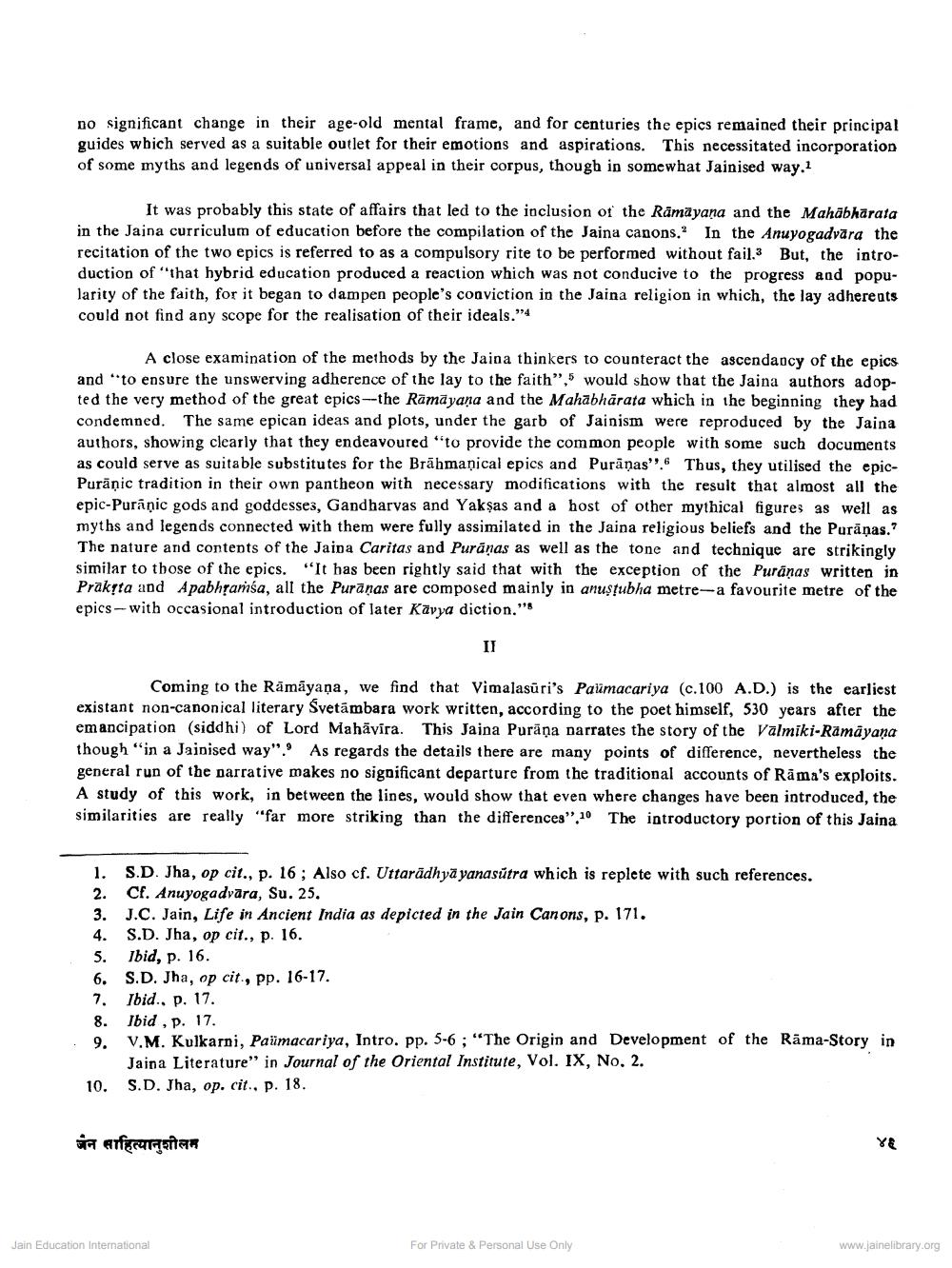Book Title: Ramayana of Valmiki and the Jain Puranas Author(s): Upendra Thakur Publisher: Z_Deshbhushanji_Maharaj_Abhinandan_Granth_012045.pdf View full book textPage 2
________________ no significant change in their age-old mental frame, and for centuries the epics remained their principal guides which served as a suitable outlet for their emotions and aspirations. This necessitated incorporation of some myths and legends of universal appeal in their corpus, though in somewhat Jainised way.1 It was probably this state of affairs that led to the inclusion of the Rāmāyana and the Mahabharata in the Jajna curriculum of education before the compilation of the Jaina canons. In the Anuyogadvāra the recitation of the two epics is referred to as a compulsory rite to be performed without fail.3 But, the introduction of that hybrid education produced a reaction which was not conducive to the progress and popularity of the faith, for it began to dampen people's conviction in the Jaina religion in which, the lay adherents could not find any scope for the realisation of their ideals."4 A close examination of the methods by the Jaina thinkers to counteract the ascendancy of the epics and to ensure the unswerving adherence of the lay to the faith”,5 would show that the Jaina authors adopted the very method of the great epics--the Ramayana and the Mahabharata which in the beginning they had condemned. The same epican ideas and plots, under the garb of Jainism were reproduced by the Jaina authors, showing clearly that they endeavoured to provide the common people with some such documents as could serve as suitable substitutes for the Brāhmanical epics and Purānas''. Thus, they utilised the epicPurāņic tradition in their own pantheon with necessary modifications with the result that almost all the epic-Puranic gods and goddesses, Gandharvas and Yakşas and a host of other mythical figures as well as myths and legends connected with them were fully assimilated in the Jaina religious beliefs and the Purānas.? The nature and contents of the Jaina Caritas and Puranas as well as the tone and technique are strikingly similar to those of the epics. "It has been rightly said that with the exception of the Puranas written in Prakta and Apabhşamsa, all the Purānas are composed mainly in anuştubha metre-a favourite metre of the epics -- with occasional introduction of later Kavya diction." Coming to the Rāmāyaṇa, we find that Vimalasūri's Paümacariya (c.100 A.D.) is the earliest existant non-canonical literary Svetambara work written, according to the poet himself, 530 years after the emancipation (siddhi) of Lord Mahāvīra. This Jajna Purāņa narrates the story of the Valmiki-Ramāyana though "in a Jainised way". As regards the details there are many points of difference, nevertheless the general run of the parrative makes no significant departure from the traditional accounts of Rama's exploits. A study of this work, in between the lines, would show that even where changes have been introduced, the similarities are really "far more striking than the differences" 10 The introductory portion of this Jaina 1. 2. 3. 4. 5. S.D. Jha, op cit., p. 16; Also cf. Uttarādhya yanasūtra which is replete with such references. Cf. Anuyogadvara, Su. 25. J.C. Jain, Life in Ancient India as depicted in the Jain Canons, p. 171. S.D. Jha, op cit., p. 16. Ibid, p. 16. S.D. Jha, op cit., pp. 16-17. Ibid., p. 17. Ibid , p. 17. V.M. Kulkarni, Paümacariya, Intro. pp. 5-6 ; "The Origin and Development of the Rāma-Story in Jaina Literature" in Journal of the Oriental Institute, Vol. IX, No. 2. S.D. Jha, op. cit., p. 18. 7. 8. . 9. 10. जैन साहित्यानुशीलम Jain Education International For Private & Personal Use Only www.jainelibrary.orgPage Navigation
1 2 3 4 5 6 7
